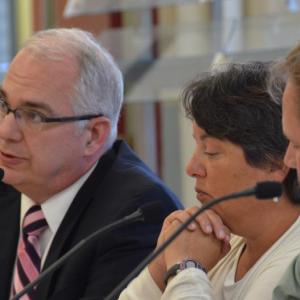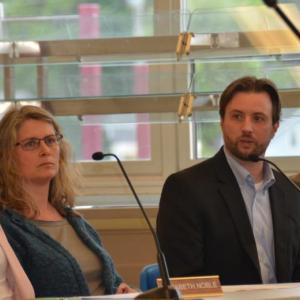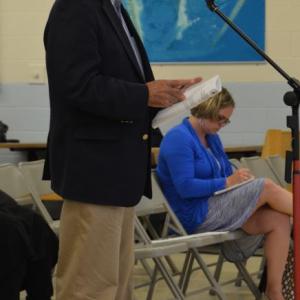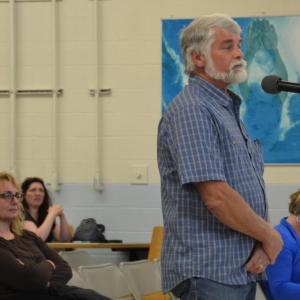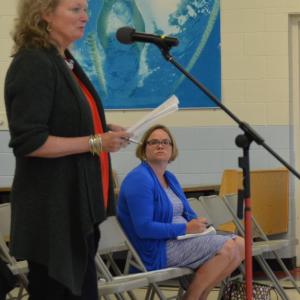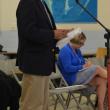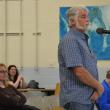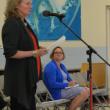Give community a chance to brainstorm about MET before tear-down, citizens tell school board
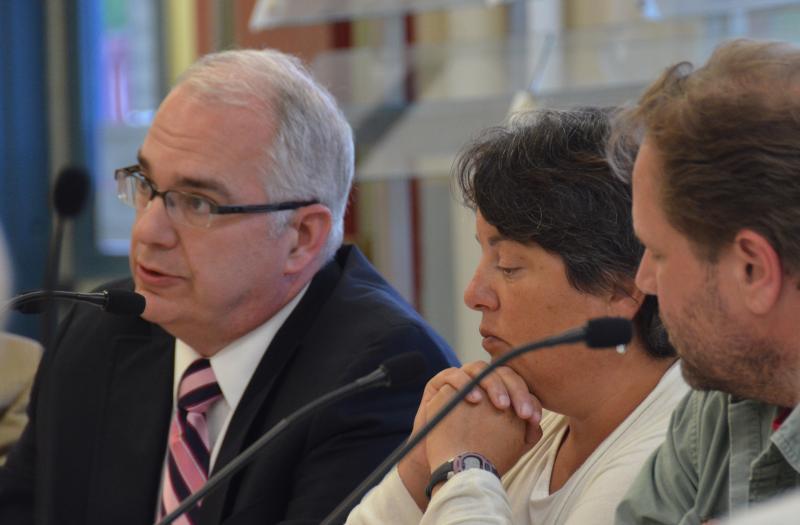 Attorney William Stockmeyer, of the Portland-based firm Drummond Woodsum, sits with School Administrative District 28 Superintendent Maria Libby and board Chairman Matt Dailey, July 13, in the Camden-Rockport Middle School cafeteria for a special meeting about the future of Mary E. Taylor school. (Photo by Lynda Clancy)
Attorney William Stockmeyer, of the Portland-based firm Drummond Woodsum, sits with School Administrative District 28 Superintendent Maria Libby and board Chairman Matt Dailey, July 13, in the Camden-Rockport Middle School cafeteria for a special meeting about the future of Mary E. Taylor school. (Photo by Lynda Clancy)
 Eric Kangas, of Camden, addresses the SAD 28 School Board. (Photo by Lynda Clancy)
Eric Kangas, of Camden, addresses the SAD 28 School Board. (Photo by Lynda Clancy)
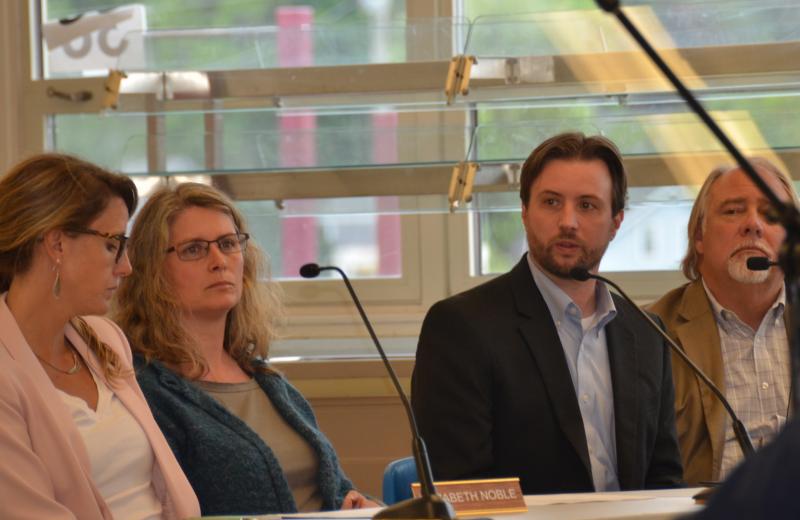 SAD 28 School Board members Elizabeth Noble and Sarah Bradley Prindiville, along with Tyler Barter, Senior Architect, Oak Point Associates and Rob Tillotson, President, Oak Point Associates. (Photo by Lynda Clancy)
SAD 28 School Board members Elizabeth Noble and Sarah Bradley Prindiville, along with Tyler Barter, Senior Architect, Oak Point Associates and Rob Tillotson, President, Oak Point Associates. (Photo by Lynda Clancy)
 Tyler Barter, Senior Architect, Oak Point Associates. (Photo by Lynda Clancy)
Tyler Barter, Senior Architect, Oak Point Associates. (Photo by Lynda Clancy)
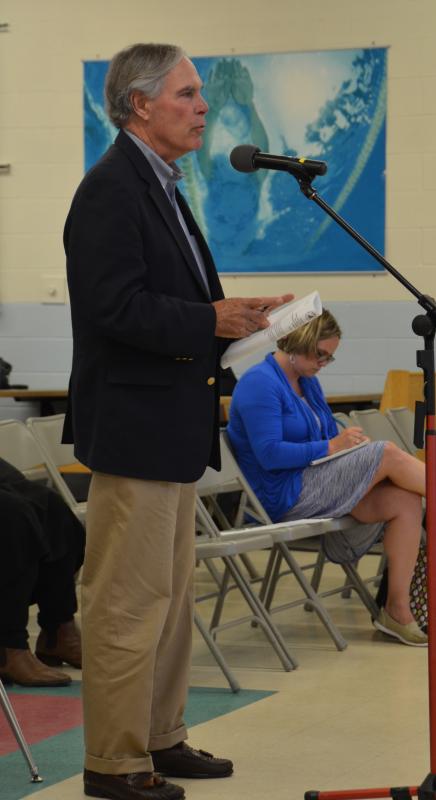 Christopher Closs, of Maine Preservation, addresses the SAD 28 School Board. (Photo by Lynda Clancy)
Christopher Closs, of Maine Preservation, addresses the SAD 28 School Board. (Photo by Lynda Clancy)
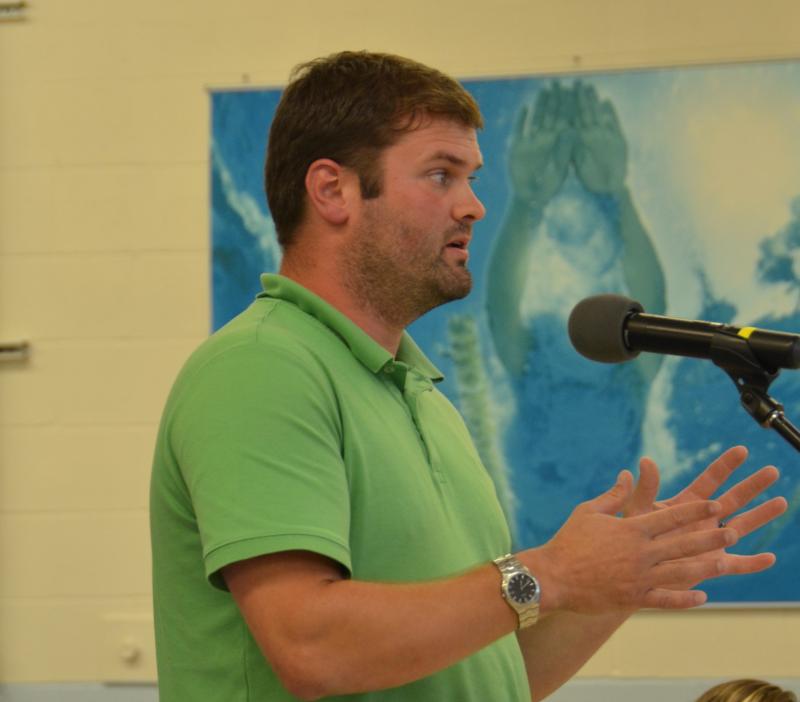 Tyler Smith, of Camden, addresses the SAD 28 School Board. (Photo by Lynda Clancy)
Tyler Smith, of Camden, addresses the SAD 28 School Board. (Photo by Lynda Clancy)
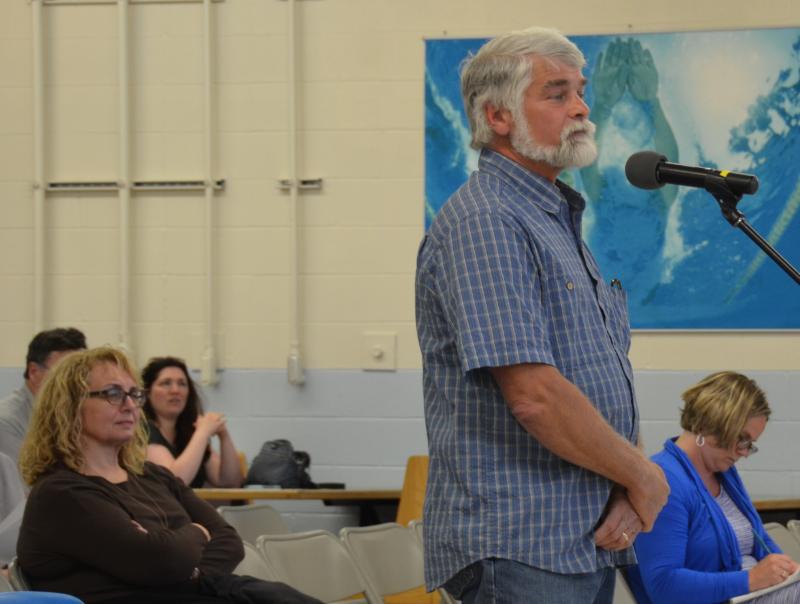 Stuart Smith, of Camden, addresses the SAD 28 School Board. (Photo by Lynda Clancy)
Stuart Smith, of Camden, addresses the SAD 28 School Board. (Photo by Lynda Clancy)
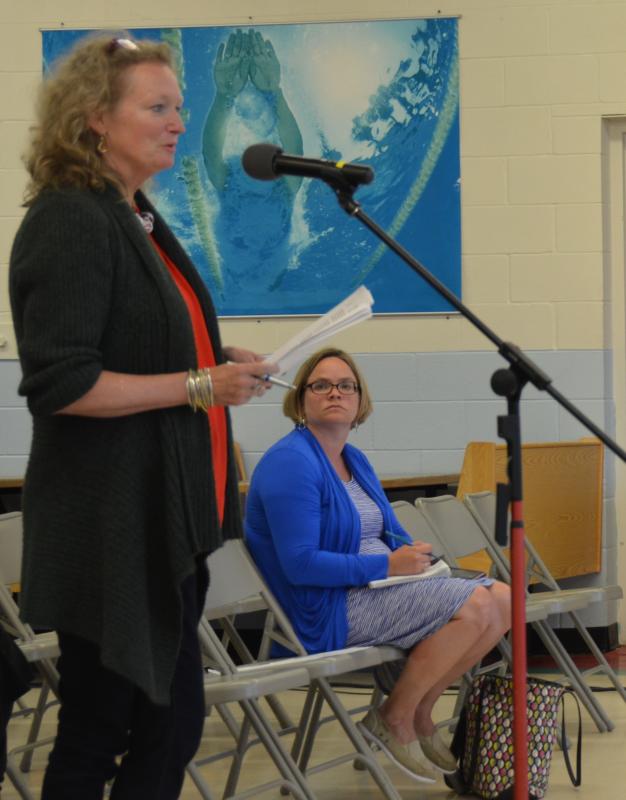 Robin MacIntosh addresses the SAD 28 School Board. (Photo by Lynda Clancy)
Robin MacIntosh addresses the SAD 28 School Board. (Photo by Lynda Clancy)
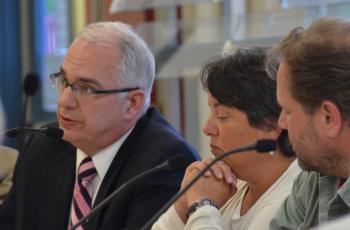 Attorney William Stockmeyer, of the Portland-based firm Drummond Woodsum, sits with School Administrative District 28 Superintendent Maria Libby and board Chairman Matt Dailey, July 13, in the Camden-Rockport Middle School cafeteria for a special meeting about the future of Mary E. Taylor school. (Photo by Lynda Clancy)
Attorney William Stockmeyer, of the Portland-based firm Drummond Woodsum, sits with School Administrative District 28 Superintendent Maria Libby and board Chairman Matt Dailey, July 13, in the Camden-Rockport Middle School cafeteria for a special meeting about the future of Mary E. Taylor school. (Photo by Lynda Clancy)
 Eric Kangas, of Camden, addresses the SAD 28 School Board. (Photo by Lynda Clancy)
Eric Kangas, of Camden, addresses the SAD 28 School Board. (Photo by Lynda Clancy)
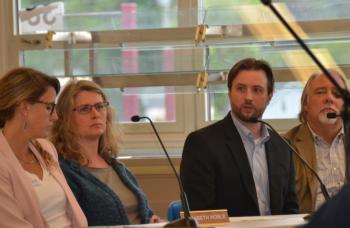 SAD 28 School Board members Elizabeth Noble and Sarah Bradley Prindiville, along with Tyler Barter, Senior Architect, Oak Point Associates and Rob Tillotson, President, Oak Point Associates. (Photo by Lynda Clancy)
SAD 28 School Board members Elizabeth Noble and Sarah Bradley Prindiville, along with Tyler Barter, Senior Architect, Oak Point Associates and Rob Tillotson, President, Oak Point Associates. (Photo by Lynda Clancy)
 Tyler Barter, Senior Architect, Oak Point Associates. (Photo by Lynda Clancy)
Tyler Barter, Senior Architect, Oak Point Associates. (Photo by Lynda Clancy)
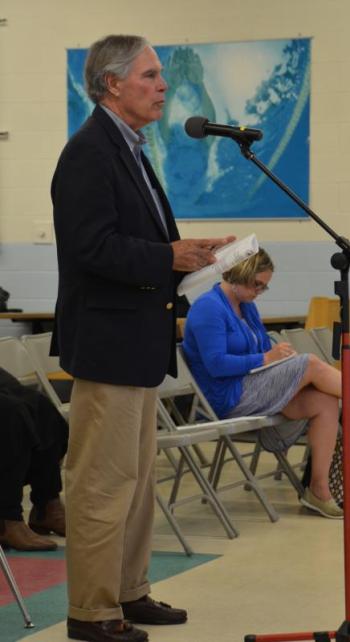 Christopher Closs, of Maine Preservation, addresses the SAD 28 School Board. (Photo by Lynda Clancy)
Christopher Closs, of Maine Preservation, addresses the SAD 28 School Board. (Photo by Lynda Clancy)
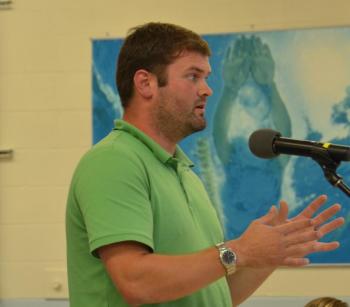 Tyler Smith, of Camden, addresses the SAD 28 School Board. (Photo by Lynda Clancy)
Tyler Smith, of Camden, addresses the SAD 28 School Board. (Photo by Lynda Clancy)
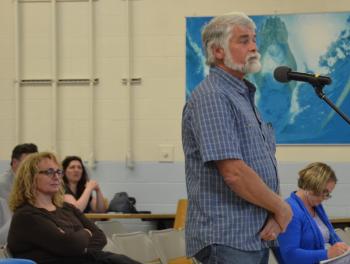 Stuart Smith, of Camden, addresses the SAD 28 School Board. (Photo by Lynda Clancy)
Stuart Smith, of Camden, addresses the SAD 28 School Board. (Photo by Lynda Clancy)
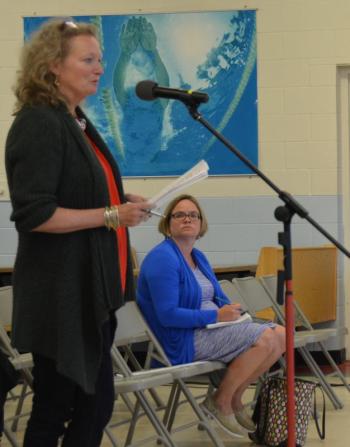 Robin MacIntosh addresses the SAD 28 School Board. (Photo by Lynda Clancy)
Robin MacIntosh addresses the SAD 28 School Board. (Photo by Lynda Clancy)
CAMDEN — While there was no official vote, the Camden-Rockport School Board has given a nod toward entertaining ideas of keeping the Mary E. Taylor school from the wrecking ball. Given that, a group of citizens are responding to the possibility, with local developer Stuart Smith, saying he would investigate assembling a group of investors to acquire and repurpose the 1925-built school.
And, Camden Select Board Chairman John French is talking with SAD 28 School Board Chairman Matt Dailey about scheduling a joint meeting, and drawing up an agenda.
The agreement to hear ideas about saving the MET building did not come easily, and followed two hours of conversation July 13 at a special school board meeting held in the Camden-Rockport Middle School cafeteria. Approximately 30 citizens, including several Camden Select Board members, attended that meeting, where many told the board, under no uncertain terms, that the school board was obligated to allow time for proposals to percolate.
Several days following that meeting, School Administrative District 28 Superintendent Maria Libby said Board Chairman Matthew Dailey would release a summary statement for parties interested in MET.
At issue is a growing interest by some local citizens to keep the 1925-built MET building standing, and using it for community, education and/or commercial purposes. The school board, on the other hand, has incorporated MET’s demolition into its larger overhaul of the Knowlton Street middle school complex, and has said the public knew of the MET demise when Camden and Rockport voters went to the polls June 13 and approved the $26 million investment.
Those distinct opinions were articulated July 13, and few minced words as they either approached the microphone and addressed the school board, its attorney and architects, or when the school board members themselves shot back from their seats in the front of the room. (See attached Geoff Parker-produced video for the meeting proceedings).
At the July 13 meeting
The school board had convened the meeting to discuss with the public the “consideration of possible options” for the school’s future. The focus on MET has been growing, as Camden and the school district separately addressed interest raised by citizens who want to explore repurposing MET.
The two-story brick structure was built in 1925 and represents period architecture. Those hoping it is renovated for commercial, educational or residential use maintain its proximity to downtown Camden further heightens its appeal to potential developers.
They also maintain that Maine historic preservation tax credits could be used to developer advantage. Furthermore, they said the renovation of the 24,000-square-foot MET would help accommodate the school district itself, which has been talking about the need for administrative offices for more than a decade. SAD 28 and the Five Town CSD superintendent and other administrators have occupied the Bus Barn, on Lion’s Lane, next door to MET, since the early 1990s.
The school board has acknowledged that the the district could have renovated MET for office spaces, but chose not to, because of the cost to taxpayers. If a developer went forward with the MET renovation, the school board has stipulated it wants half of the space for its offices.
As the architectural plans now stand, MET is to be demolished, along with the entire former Camden-Rockport High School and the Andrews Wing, which was constructed to connect MET and the high school.
In MET’s place, a new athletic practice field would be created, alongside the new middle school building.
Voters endorsed the expenditure at the June Town Meeting polls, but there is discrepancy now as to whether they approved the MET tear-down when they voted. According to the school board and its counsel, a new public vote would be required to keep MET standing.
Current state of MET building
According to a fact sheet released by the district:
MET is 24,000 square feet in size.
It does not have a heating source.
If it were left standing, after the Andrews Wing was demolished, MET would be left with a gaping hole open to the outside.
Gaping hole on one side, with no heat nor electrical.
“It doesn’t seem quite as great when it doesn’t have the rest of the building here,” said Board Chairman Matt Dailey.
The district is responsible for maintaining the building until ownership is transferred.
The cost to restore it as a standing building with no renovation is approximately $300,000.
The cost to renovate for district use is $3.8 to $4 million, per the district’s architect, said Board Chairman Matthew Dailey, “soup to nuts,” he said.
Current zoning is Traditional Village
The Camden-Rockport School Board has maintained that the public, and Camden’s Select Board, had ample opportunity over the past year to indicate support for keeping MET intact, but never did.
Camden resident and board Chairman Matt Dailey said July 13 that the school board was under obligation to the voters not to “significantly compromise the design of the layout and fields” that have been approved by voters.
“No matter what, the disposition [of MET] cannot impact the start of the new building or how we lay the new school out,” Dailey said.
School district Superintendent Maria Libby reinforced Dailey’s statement, saying that the project that went to the voters represented the final layout of the facility, and there was on it a practice field instead of MET.
She added, however: “Since MET has come under reconsideration, and thinking about MET staying standing, it simply means we couldn’t have that practice field. The practice field is a treat.”
She said that in December 2016, the school committee overseeing plan development, as well as the school board, heard little opposition to the MET demolition, and subsequently agreed to incorporate its demise into the overall plan.
According to the school board’s legal counsel, Attorney William Stockmeyer, of the Portland-based firm Drummond Woodsum, the school district will have to hold another ballot referendum to allow MET to remain extant.
“If you are not going to do that [tear it down] you have to back to voters to say you are not going to do that, but are going to have eventually go to voters,” said Libby.
But Dailey also said the board wanted to allow the discussion about MET’s future to remain on the table.
“It was never the intention to say we weren’t open to talk about the future of the building,” said Dailey.
The non-negotiables, he said, include a Spring 2018 groundbreaking, and that the “school district will need to go to referendum to have voters approve any use other than demolition.”
Clarifications and objections
Local developer Stuart Smith, who sat on the SAD 28 and Five Town CSD school boards himself for three terms approximately 15 years ago, said the issue was simpler than what was being discussed. Furthermore, he said, renovations should not be as costly as the board’s architects were proposing.
He said the brick Shepherd Block, in Rockport Village, had been renovated seven years for a little less that $1.7 million, and that include taking the building to residential and commercial code, installing an elevator, as well as a restaurant.
“I recognize the architect’s estimates but I would say depending on how you design any structure, they’re estimate is extremely high,” said Smith.
Camden resident and local developer Tyler Smith, who is Stuart’s son, told the board that when the public voted in June on the approximately $26 million project there was no associated timeline.
MET could be placed in escrow and demolished well into the future, he said.
“Can we let MET sit there, and put money in escrow for demolishment for a later point,” asked Smith.
School board attorney Stockmeyer said the legal angle predisposes the affirmative, and could bend toward arbitrage law, ultimately amending the original project vote.
But, he added, leaving MET standing would affect demolition costs.
Architect Tyler Barter, with Oak Point Associates, said demolishing MET at a later date would cost “significantly more money.”
He said: “If we take down everything but MET, we would have to enclose it and keep people out.”
It would present a safety question and cost “half a million to hibernate,” he said.
Board member Marcia Dietrich, of Rockport, questioned whether the district had $1 million left in project reserve to consider applying toward MET.
“Do we have more discretion with that $1 million?” she asked.
“Yes we do,” said Libby. “We just we don’t want to impact the new building.”
Former Camden Town Manager Roger Moody urged the school board to use the current conversation as “an opportunity to create community discussion.”
What is the broader vision, he said, of the Elm Street School (currently leased to the independent Montessori School) and the Bus Barn.
“It would be helpful to know what the town of Camden’s infrastructure needs are for office and building spaces,” he said. “If those things can be addressed it would benefit the community.”
Christopher Closs, an advisor with the Yarmouth-based nonprofit Maine Preservation, referenced state tax credits that could be applied to the renovation of MET, and said 75 other historic buildings, including 14 old Maine schools, had been rehabilitated with them.
“You can recover up to 40 percent of qualified expenditures,” he said.
If affordable housing credits are used, the developer can push that to 52 percent of expenses.
He said SAD 28, which owns MET, could lease the school building to a developer.
SAD 28 acquired the deed from the Town of Camden in 1968, when then Selectmen Parker Laite, Alfred Haynes, Robert MacNair, James Hall and David Hardy, sold the building and land to the district for $1.
“The building wouldn’t have to be sold to convey use,” said Closs. “It could be leased. Sullivan School is 75-year-lease from the Town of Berwick. If you are intent on retaining the land for 50-100 years that’s an option.”
Closs also said the $150,000 demolition cost associated with the MET tear-down is low, saying instead it might be “north of $200,000.”
He also referenced possible property tax revenue to the town with a renovated MET.
“It is an issue of community sustainability,” he said. “To put that building in a landfill is not without social and environmental costs.”
Camden Select Board member Marc Ratner, who also served as a liaison to the SAD 28 building committee, asked whether keeping MET extant would affect student education.
“It depends on the use,” said Libby. “I can’t predict the future. If we got to the point and someone put in 22 [residential] units, I don’t know if we would have 22 units where kids play soccer behind the school. Some uses are more compatible with education. I think a lot of parents would have opinions on what uses they would want while students are attending middle school.”
She added: “As superintendent, I work hard to spend money wisely as a district and go to taxpayers with the least tax increase possible. When I think about $300,000 to close off this building, who is going to pay that cost? I don’t want that going on the SAD 28 budget. It’s hard for us to think about money not related to education.”
Tyler Smith asked when MET is scheduled for demolition.
Architect Barter replied June 2020, “but might go sooner.”
He said the demolition debris could be used as fill for the new school construction.
There is also the architectural proposal to incorporate old pieces of MET into the new school building.
“We can’t wait until June 2020,” he said.
“We have time,” said Dailey. “We just can’t wait to very last second.”
He said the permitting process would begin in October and warned against too much time spent on monkeying around.
Stuart Smith reprimanded the board, saying: “It’s pretty obvious, the list of MET facts [see sidebar] is slanted toward tear down the building. There’s not one positive fact on the whole list.”
“What’s positive,” asked Dailey.
Smith said: “24,000 feet is a lot valuable space to community. It is an historic structure. With a building so close, you could use it for administrative offices, Zenith, after-school space.”
Smith chastised Dailey, saying he sat with him in April, and there was no site plan available.
“I am disappointed in you, Matt,” said Smith.
“There was a site plan that did not have MET in April,” said Dailey.
“When you and I sat down there was no site plan,” said Smith. “What really bothers me is the negative attitude coming from school board. You do not need to tear this building down until 2020.... I’m happy to donate the heating system to keep it operating. Keep it a little positive.”
“I think I am being honest,” said Dailey. “I have lived with this project for years. We have a responsibility to build a new school and have it open on time. I feel we have to build a new school and not have it compromised. I am trying to honest and realistic as possible. We have a limited amount of money... We’ve been waiting for 18 months. Where was everybody? I don’t want to tear down the building but I just can’t wait for someone to come around.”
Smith said: “Give the community four months to look at it.”
“They’ve had two years,” said Dailey.
It was also suggested that the school district transfer ownership of MET to the town.
“I do not want to offer to town and it just sits there,” said Dailey. “It needs a plan with endpoint goal.”
“Camden Select Board member Alison McKellar said she would be interested if there is another plan.
“I’m not interested in spending a cent of taxpayer money to look at it,” she said.
But, she suggested giving the community a chance to look at options.
In The End
Two hours later, the school board agreed, albeit not officially, to give until late September or early October citizens a chance to formulate ideas, and return to the school board for further conversation.
Libby suggested that the school board establish criteria for those citizens pursuing options.
“We need people to understand what we expect in level of details,” she said.
Rounding out the public portion of the meeting, former school board member Geoffrey Parker, who is also a former Rockport Select Board member, and who was filming the meeting for the public’s sake, urged the school board to use Washington Street meeting room or Rockport meeting room for future MET meetings, or in general, “so that people can hear this and know what’s happening.”
The board then entered executive session, citing need to consult with its attorney. Chairman Dailey further explained it was necessary to talk about the bond. This reporter objected to the motion for executive session.
The board remained behind closed doors for approximately 30 minutes with no motions made following exit.
Related stories:
Camden Select Board hopes to meet with school board Thursday evening over MET future
Future of Camden's MET building to be discussed at two board meetings, municipal and school
Maria Libby on middle school project planning and Mary E. Taylor School
Camden-Rockport Middle School building project forum tonight
The future of Camden's Mary E. Taylor School. Tear it down? Lease it to another entity?
$28 million Camden-Rockport Middle School project proceeds to vote
Opinion: Camden Rockport Middle School project examined
Letter to the editor: School board responds to Camden Planning Board project concerns
Camden Planning concerns about middle school project
Camden-Rockport leaders skeptical of $28 million middle school project
Read about the March 20 forum: Camden-Rockport board endorses public straw vote: Tear down, rebuild middle school
What to do with Camden-Rockport Middle School: Tear down, renovate, rebuild?
Camden-Rockport Middle School concepts floated: ‘Everything in pencil’
Editorial Director Lynda Clancy can be reached at lyndaclancy@penbaypilot.com; 207-706-6657

